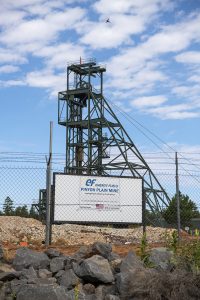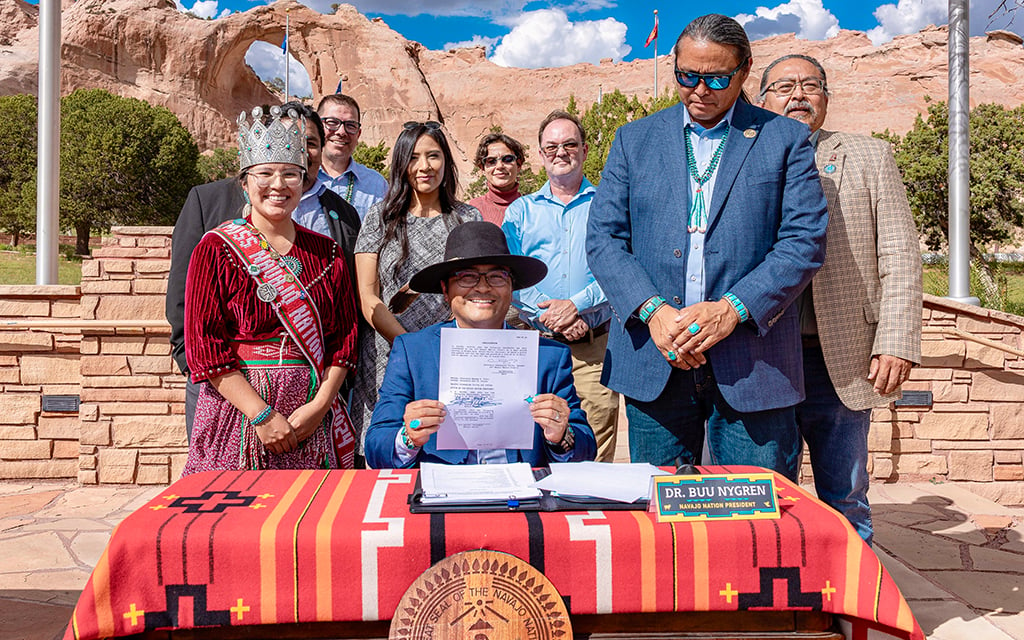PHOENIX – Carletta Tilousi was a young girl when she first heard about possible uranium mining near her home of Supai. Deep within the canyons near the Grand Canyon’s South Rim, this is where the Havasupai people reside.
From the day they were contacted about it, the Havasupai were resistant to uranium mining near their homelands.
“Our tribal leaders were approached and told that if you support this effort, we will provide education and support your tribe, since this is near your sacred mountain and aboriginal territory, and the tribe said no, the council at the time said no,” Tilousi said.
That was nearly 40 years ago, and now that same mine is finally operational. But Tilousi and the Havasupai are continuing the fight against the Pinyon Plain Mine near the Havasupai’s ancestral homelands. Tilousi serves on the White House Environmental Justice Advisory Council after previously serving 20 years on the Havasupai Tribal Council.
The Pinyon Plain Mine is owned and operated by Energy Fuels Inc., which has stated all mining operations are safe.
The Havasupai’s main area of concern is the protection of the water that flows through the Grand Canyon. Not only is this their main water source, but they are especially protective of the waterfalls and springs, including the popular tourist destination of Havasu Falls.
Havasupai translates to “people of the blue-green waters.”

Pinyon Plain Mine is on Kaibab National Forest land south of the Grand Canyon, near the Havasupai Tribe’s sacred mountain, Red Butte. The mine is inside the boundary of the Baaj Nwaavjo I’tah Kukveni National Monument. (Photo by EcoFlight via Grand Canyon Trust)
Uranium mining has been a point of contention for Southwest tribal nations for decades.
The Navajo Nation faced uranium exposure from mining that was conducted before the Cold War leading to various health issues, such as increased lung cancer rates.
“I remember the stories that they shared and the illnesses that caused a lot of strife and death in their communities really made us understand that this was a dangerous ore that should not be removed,” Tilousi said.
In the early 1980s, thousands of uranium mine claims were submitted for areas within Kaibab National Forest and around the Grand Canyon; most were denied. In October 1984, Energy Fuels submitted a Plan of Operations to mine uranium from the Pinyon Plain Mine, formerly known as the Canyon Uranium Mine.
The U.S. Forest Service completed an environmental impact statement to evaluate and modify the operation plans, and in 1986, the mine was approved and exploratory drilling began.
Uranium is the fuel source that is most widely used for nuclear energy, and the mine contains 1.6 million pounds of uranium, one of the largest deposits in the United States, according to Energy Fuels.
The Pinyon Plain Mine is between the Grand Canyon’s South Rim and Red Butte, a traditional cultural property in the Kaibab National Forest. The mine also sits atop the Redwall-Muav aquifer, the primary source of groundwater for the Grand Canyon.
The Havasupai and neighboring tribal nations fought the mine in court, but an appeals court affirmed the decision to allow mining in August 1991. Fluctuating uranium prices delayed interest until a surge in 2007.
Once again, thousands of uranium mine claims came pouring in, rekindling the Havasupai’s fight to protect their traditional lands.
In an effort to give federal protection to the area and alleviate the Havasupai’s concerns, former U.S. Secretary of State Ken Salazar withdrew public lands near the Grand Canyon from new mining claims for a 20-year period in January 2012.
Additionally, in August of last year, President Joe Biden signed a proclamation establishing the Baaj Nwaavjo I’tah Kukveni – Ancestral Footprints of the Grand Canyon National Monument, which further protected the area from future mining claims.
Despite these additional protections, an 1872 mining law stated that anyone with “valid existing rights” could continue mining regardless of a ban. Since the Pinyon Plain Mine Plan of Operations was already approved, Energy Fuels was exempt from the ban and could resume operations. Energy Fuels had the original plan of operations reaffirmed by the U.S. Forest Service in 2012 and acquired additional permits from the Environmental Protection Agency and state of Arizona in the following years.
In December 2023, Energy Fuels announced in a news release that it had commenced production at the Pinyon Plain Mine.
Despite heavy opposition from local tribal nations and advocacy groups, including the Sierra Club Grand Canyon Chapter and Grand Canyon Trust, Energy Fuels said they are doing everything as safely as possible.
“It’s unfortunate, there’s a lot of people that are being scared by what we’re doing when they really have no reason to be afraid of it,” said Curtis Moore, senior vice president of marketing and corporate development at Energy Fuels.
“We’ve learned a lot. We do things far better today than we did back in those days,” Moore said. “There’s really no evidence that the modern uranium industry has caused any impacts to human health, the environment, over the past 50, 60, 70 years honestly.”
Studies and analysis conducted by the Forest Service and Arizona Department of Environmental Quality concluded that the mine poses little risk of contamination to any groundwater in the area. Additionally, aquifer protection permits were issued
In August, Arizona Attorney General Kris Mayes called for an updated environmental impact study on the Pinyon Plain Mine. “The most recent environmental impact study is nearly four decades old and relies on outdated data,” Mayes said in a news release.

A view of the headrig at Pinyon Plain Mine taken outside the fence, inside the boundary of Baaj Nwaavjo I’tah Kukveni National Monument. (Photo by Blake McCord via Grand Canyon Trust)
Sandy Bahr, director of the Sierra Club’s Grand Canyon Chapter, has been heavily involved with the litigation and environmental efforts of the Havasupai for many years.
“There’s a lot of new information that we have since then that should be considered relative to evaluating the impacts of this mine, trying to limit the harm from it,” Bahr said, noting the Forest Service is looking at that request.
Energy Fuels has come under fire over the controversial hauling of ore across the Navajo Nation from the mine to Utah. Energy Fuels said in the past it would give notice before it began shipping the ore, but on July 30, the first shipment made its way to the White Mesa Mill in Utah – angering Navajo Nation leaders.
Navajo Nation President Buu Nygren issued a temporary ban on the transportation of ore through their tribal lands, and negotiations are ongoing to resolve the issue.
Neighboring tribal members and advocacy groups organized demonstrations in support of the Navajo Nation.
“The federal government and the state government signed off on it,” Energy Fuels’ Moore said. “Some may think that those (regulations) were not appropriate or protective enough, but again, we’ve followed the law at every aspect.”
As uranium production and extraction continue at Pinyon Plain Mine, organizations and Arizona’s tribal nations will continue their efforts against the mine.
“If we don’t advocate, then someone else will get hurt, some elder will get hurt … if we didn’t advocate enough, then it was partially our doing,” Tilousi said.


